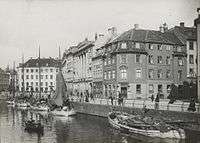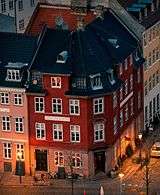Sundorph House
| Sundorph House | |
|---|---|
| Sundorphs Gård | |
 The building seen from Boldhusgade | |
| General information | |
| Architectural style | Neoclassical |
| Location | Copenhagen, Denmark |
| Coordinates | 55°40′38.37″N 12°34′53.63″E / 55.6773250°N 12.5815639°ECoordinates: 55°40′38.37″N 12°34′53.63″E / 55.6773250°N 12.5815639°E |
| Construction started | 1796 |
| Completed | 1797 |
The Sundorph House is a Neoclassical property at Ved Stranden 10 in the Old Town of Copenhagen, Denmark.
History
.png)
Hans Pay, who was born in Drammen in 1738, established as a porcelain seller in Copenhagen 1768. He was licensed as a grocer (urtekræmmer) in 1771 and 1776 but died in 1777. His widow, Mette Christine née Collstrup (1752-1834) took over the operations of the company but it was ceded to her new husband when she married Søren Christian Sundorph (1743-1794) on 21 December 1778. His birth name was Søren Christensen but he had assumed the name Sundorph after his home town Nørre Sundby in the north of Jutland.[1] When he died in 1794, Mette Christine Sundorph once again took over the operations of the company whose name was changed to Mette Christine sal. Sundorphs Enke & Co. ("Metta Christine late Sundorph's Widow & Co.). The Sundorph House was the following year destroyed in the Copenhagen Fire of 1794. The company was then run from a wooden shed on Slotsholmen until the house at Ved Stranden had been rebuilt to a new design in 1797.

The name of the company was changed to Sundorphs Enke & søn (Sundorph's Widown & Son") when her elder of her two sonsson, Christian Severin Sundorph (f1780–1826), joined it in 1812. The younger son, Hans Pay Sundorph (1790–1860), joined the company in 1816 and became its sole owner with his brothers death in 1826. The company then took the name H. P. Sundorph. It was later passed on to his son, Georg Christian Sundorph (1826—1875), who had joined it in 1856. His widow, Anna Margrethe Sundorph (née v. Stöcken) ran it after his death. Her son, Hans Pay Sundorph, became a partner in the company in 1884 and its sole owner in 1894. It had by then become a tea wholesaler.
The Danish Chamber of Commerce (Grosserer-Societetet) was based in the building prior to their acquisition of the Exchange Building (Børsen) on the other side of the canal in 1857.[2] The building was listed in 1918.[3]
Architecture

The house is built in the Baroque style and consists of three floors, Mansard roof and a cellar. The facade on Boldhusgade is nine bays long while the facade fronting the canal is just three bays long. The roof is clad with black-glazed tiles. A three-bay wall dormer faces Boldhusgade and a single-bay wall dormer faces Ved Stranden. The four-storey side wing is five bays long.
Today
The building is now home to a combined wine shop, wine bar and lunch restaurant in the ground floor.[4]
See also
References
- ↑ "H. P. SUNDORPH". coneliand.dk (in Danish). Retrieved 27 October 2016.
- ↑ "Ved Stranden 10". indenforvoldene.dk (in Danish). Retrieved 27 October 2016.
- ↑ "Sag: Sundorphs Hus". Kulturstyrelsen (in Danish). Retrieved 27 October 2016.
- ↑ "SaVed Stranden 10". aok.dk (in Danish). Retrieved 27 October 2016.
